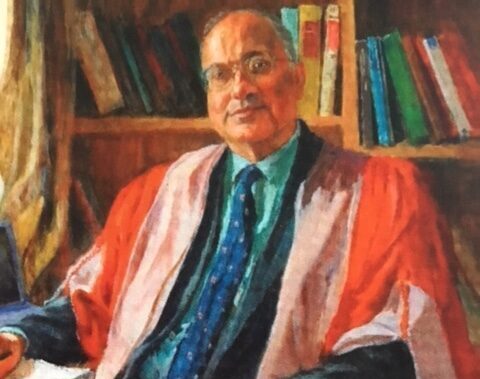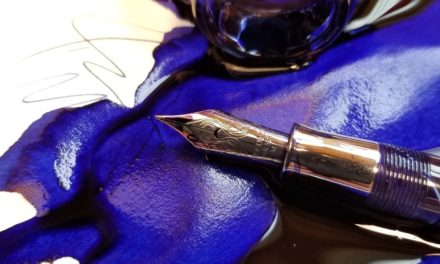Whether or not Man is the measure of all things he certainly measures all things, none requiring more concentration than the apparently simple matter of measuring up a painting to be framed.
My wife Rani had done some paintings she wished to have considered for exhibition by the Cambridge Drawing Society. The Society required that these be framed in a very specific way with special expensive art glass. They listed several local framers.
To our surprise, one framer had an address on nearby Millington Road. Of all places. Big houses on a private road. Not at all the place where any business would be done. We were intrigued, made a phone call and arranged a meeting.
The framer’s workroom was a small, neatly-kept room round the side of the house, a side door to the house just beyond it. It looked as if the framer was confined to a separate entrance.
Haroon – for such was the name of the framer – was an elderly man who sat as impassive as an Abbasid caliph behind his work table, framed in his turn by lengths of wood, tools and pictures. Rani took her time choosing colours for her frames while Haroon measured up her paintings. I was requested to pass across to him various rulers and lengths of wood.
My wife being concerned with cost, Haroon told her he had been assured by several members of the Drawing Society that his prices were less than half of those pertaining elsewhere in town. No bargaining was required in this bazaar.
Negotiations being completed, Rani took it upon herself to ask if Haroon lived in the house. Yes – actually he owned it. Did he have some connection with India? Yes, he had been born in Calcutta (as it then was) but grew up in Delhi. He had been forced to leave Delhi for Karachi during the Partition riots as a refugee and had eventually come on to Britain.
A Muslim then? Well, yes and no. Seeing what was done in the name of religion in 1947 had caused him to become an agnostic. But he knew Urdu? Of course – and he sped us on our way with several couplets from Ghalib. Delhi had been a dangerous place to be in Ghalib’s time too. It was a pleasure to hear his verses in the peaceful setting of a secluded Cambridge street.
You may measure a man, you may frame him, in many ways and it took a quick resort to the Internet as well as a subsequent meeting with Haroon himself to fill in the picture, a full-length portrait of him. Looking back, his story seemed as remote as the antiquarian prints and aquatints of 18th century Oxford and Varanasi hanging on the walls on his workroom – alongside the contemporary photo of his grandchildren.
Haroon’s family, both men and women, had flourished in British India. His maternal grandfather had made a fortune building parts of New Delhi according to Lutyens’ designs. Mind you, the next generation had been forced to go to Germany for a technical education, being persona non grata in both India and Britain on account of their participation in Gandhi’s civil disobedience campaigns.
Then came Partition and everything was lost – except, a big exception at the time, their lives. The grandfather fled Calcutta for what would become – when the world turned round once again – Bangladesh. Haroon’s father, a civil servant tasked with dividing assets between Pakistan and India, had his car rammed by rioters in New Delhi for his pains and, not a moment too soon, abandoned his house and possessions and fled with his family concealed crouched out of sight in a car to take a flight to Karachi.
Haroon became doubly displaced when his father, having been posted to London briefly, had to return to Karachi, leaving Haroon and his younger brother in England to continue their education. From prospective landlords they experienced their share of the anti-Paki prejudice that was aimed, indiscriminately, at anybody from anywhere in the Subcontinent.
Lucky not to have been hacked to death in Delhi, the two brothers one day narrowly escaped being cut up with razor-blades by Teddy Boys in Shepherds Bush. Then when Haroon, after graduation, took a job as an apprentice with GEC in Birmingham, he found he was segregated from the other apprentices and, though better qualified, paid less.
Perhaps growing up short-sighted in school, as Haroon did, can give you the resilience to overcome prejudice. The maths and physics teachers in the polytechnic where he had studied for his A levels recognized his abilities and, while he could not apply to the intellectual mecca of Cambridge on account of a lack of Latin, he graduated from Imperial College with a first class degree. After the year when he was underpaid if not altogether overlooked, he won a scholarship to King’s College, Cambridge to do research for a Ph.D. in engineering.
It was never plain sailing for an immigrant even at liberal-minded Cambridge but Haroon the mathematician was perhaps aided at times by his skill as a cricketer – he retired from the game only at 50 when his batting average dropped to 33 – and even more so by a couple of stimulating sabbatical years in the U.S.A. These took him to the cutting edge of micro-electronics and nano-technology.
Once overlooked for promotion when a Lecturer in Engineering, he was eventually appointed a Professor at the august Cavendish Lab. Unable at one time to find a college fellowship, he was eventually overwhelmingly elected Master of one of Cambridge’s most ancient Colleges, Corpus Christi. In those days, such a story must have seemed as fanciful as anything in The Arabian Nights.
Retirement is a time to take stock, to leave behind those two impostors, Triumph and Disaster. At 75, Emeritus Professor Haroon, a man whose measure had been taken, Fellow of any number of Institutes you care to name, decided to learn a craft that requires but a modicum of mathematical precision to take the measure of things. It was as a picture-framer we caught up with him.



